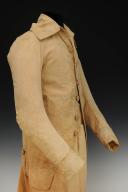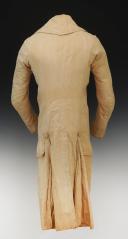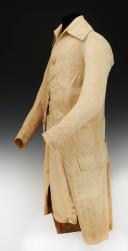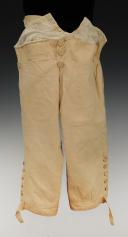
INSPECTOR'S COAT AND BRIEFS AT NANKIN REVIEWS, regulation messidor An VIII (1800), Consulat. 27228
Sold out
INSPECTOR'S COAT AND BRIEFS AT NANKIN REVIEWS, regulation messidor An VIII (1800), Consulat. 27228
HABIT
Long coat entirely in nankeen canvas, embroidered on the collar and front facings, the lapels, the back pockets and the turn-ups of foliage branches in ivory cotton thread. At the front of the coat, six wooden uniform buttons covered with nankeen canvas embroidered with foliage, diameter 2.4 cm, only the top two buttonholes are used. Flap collar, width 11.5 cm. Straight facings, H 7.3 cm. Rear flap pockets, H 9 cm, width 19.5 cm. Waist bow with a dress button. Each basque is decorated with a button at the bottom. Interior lining in white cotton canvas.
CHEEKY
Briefs in nankin canvas, bridge model, closing at the front with a fly with three wooden buttons covered in nankin canvas, button diameter 2 cm. Part covered with a flap measuring 14 cm and 34 cm wide which closes with one of the fly buttons and a button on each side at the front pockets, diameter 1.6 cm. Front patch pockets on each side of the 15.5 cm wide fly. Belt, approximately 7.3 cm high, closed with fly buttons and has a small coin pocket 7.3 cm wide. Two side pockets 16 cm high. Rear adjusted by means of a martingale. Bottom of the legs tightened with five buttons, diameter 1.2 cm, and a martingale at the bottom. White wool canvas lining.
Waist: 94 cm.
H of legs from waist to bottom of leg: 56 cm.
H of legs from crotch to bottom of leg: 37 cm.
France.
Consulat.
Very good state.
NOTE :
The color name nankeen is a trade name in the field of clothing and dyeing, of which there are two interpretations. One refers to the light yellow or beige, between apricot and buff, of the tight cotton fabric called nankin, originally made in the city of Nanking, then in India and other places in the world; the other designates a particular bright yellow, a probable reference to the imperial color of China. This fabric was introduced in Europe, made in Italy in Bologna and Florence, then in France in Lyon from the 16th century, Tours, Avignon, Paris and Montpellier, for chair and furniture linings. This fabric was used mainly because of its strength in men's clothing for summer outfits at the beginning of the 19th century (trousers, vest, jacket).
In the French army, an order of the day of 30 Germinal Year
In order to protect French trade, a decree dated February 22, 1806 prohibited the importation of white cotton fabrics among others. Woolen cottons are subject to a tax upon entry into the territory of the empire.
HABIT
Long coat entirely in nankeen canvas, embroidered on the collar and front facings, the lapels, the back pockets and the turn-ups of foliage branches in ivory cotton thread. At the front of the coat, six wooden uniform buttons covered with nankeen canvas embroidered with foliage, diameter 2.4 cm, only the top two buttonholes are used. Flap collar, width 11.5 cm. Straight facings, H 7.3 cm. Rear flap pockets, H 9 cm, width 19.5 cm. Waist bow with a dress button. Each basque is decorated with a button at the bottom. Interior lining in white cotton canvas.
CHEEKY
Briefs in nankin canvas, bridge model, closing at the front with a fly with three wooden buttons covered in nankin canvas, button diameter 2 cm. Part covered with a flap measuring 14 cm and 34 cm wide which closes with one of the fly buttons and a button on each side at the front pockets, diameter 1.6 cm. Front patch pockets on each side of the 15.5 cm wide fly. Belt, approximately 7.3 cm high, closed with fly buttons and has a small coin pocket 7.3 cm wide. Two side pockets 16 cm high. Rear adjusted by means of a martingale. Bottom of the legs tightened with five buttons, diameter 1.2 cm, and a martingale at the bottom. White wool canvas lining.
Waist: 94 cm.
H of legs from waist to bottom of leg: 56 cm.
H of legs from crotch to bottom of leg: 37 cm.
France.
Consulat.
Very good state.
NOTE :
The color name nankeen is a trade name in the field of clothing and dyeing, of which there are two interpretations. One refers to the light yellow or beige, between apricot and buff, of the tight cotton fabric called nankin, originally made in the city of Nanking, then in India and other places in the world; the other designates a particular bright yellow, a probable reference to the imperial color of China. This fabric was introduced in Europe, made in Italy in Bologna and Florence, then in France in Lyon from the 16th century, Tours, Avignon, Paris and Montpellier, for chair and furniture linings. This fabric was used mainly because of its strength in men's clothing for summer outfits at the beginning of the 19th century (trousers, vest, jacket).
In the French army, an order of the day of 30 Germinal Year
In order to protect French trade, a decree dated February 22, 1806 prohibited the importation of white cotton fabrics among others. Woolen cottons are subject to a tax upon entry into the territory of the empire.
Reference :
27228
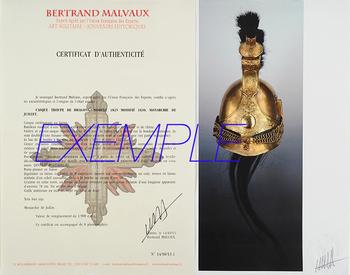
Next update Friday, april 4th at 1:30 PM
FOR ALL PURCHASES, PAYMENT IN MULTIPLE CHECKS POSSIBLE
bertrand.malvaux@wanadoo.fr 06 07 75 74 63
An authenticity certificate of the item including the description published on the site, the period, the sale price, accompanied by one or more color photographs is automatically provided for any item priced over 130 euros. Below this price, each certificate is charged 5 euros.
Only items sold by me are subject to an authenticity certificate, I do not provide any expert reports for items sold by third parties (colleagues or collectors).


